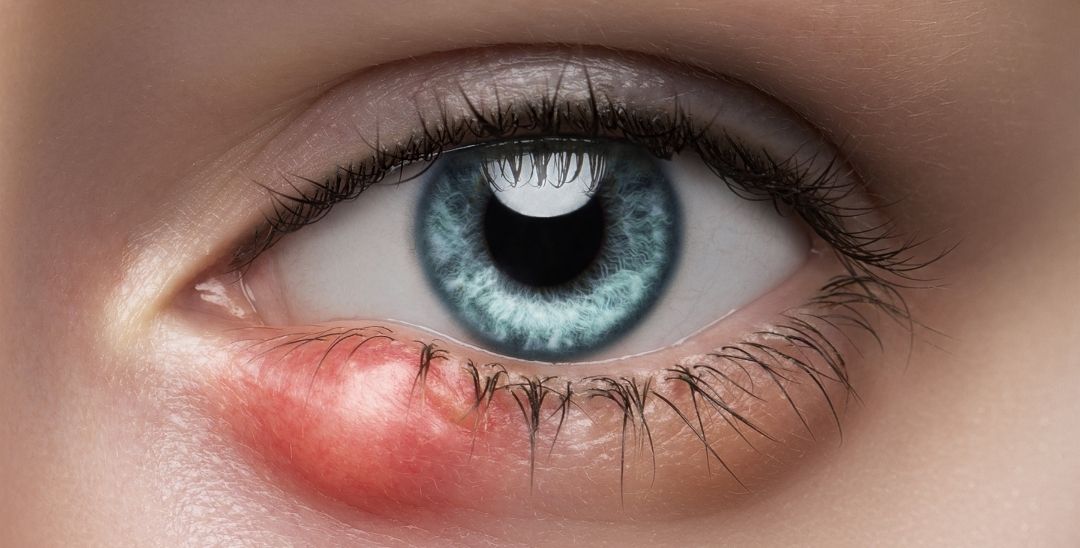For people who suffer from blepharitis (pronounced blef-uh-RYE-tis), a chronic inflammation of the eyelids, finding relief can feel like you’re playing an endless game of hide and seek.
Between the burning, crusting, itching, and irritation - managing symptoms often involves multiple visits to your health care provider, prescription medications, and specialized treatments. However, at-home therapies can provide relief and help manage symptoms.
If you’re one of the 37% to 50%¹ of people with dry eye who suffer from blepharitis, this comprehensive guide provides several at-home treatment options, so you can stop seeking answers and start feeling better.
Understanding Blepharitis
Before diving into the at-home treatment options, it’s important to understand what blepharitis is and its underlying causes, which include:
- Allergies, including allergic reactions to contact lenses, medications, or makeup
- Bacterial or viral infections
- Clogged or malfunctioning oil glands
- Dry eye
- Eyelash lice or mite infestations
- Skin conditions
Anterior Blepharitis vs. Posterior Blepharitis
There are two main types of blepharitis.
- Anterior blepharitis affects the outer eyelid, where the eyelashes attach. Bacterial infections or seborrheic dermatitis (a skin condition that causes dandruff) can cause anterior blepharitis. For example, bacteria can colonize the eyelid margin, producing toxins that irritate the skin and eyelashes. Seborrheic dermatitis can cause oily or flaky skin that clogs the pores and hair follicles.
- Posterior blepharitis, commonly known as meibomian gland dysfunction, affects the eyelids’ inner edge, which touches the eyeball. In this form, the meibomian glands that secrete oil to prevent tears from evaporating too quickly become inflamed due to bacterial infection or clogged pores.
Complications of Untreated Blepharitis
Although blepharitis isn’t typically a serious condition, it’s essential to treat it promptly. If left untreated, it can lead to the following complications:
- A chalazion or stye
- Chronic dry eye syndrome
- Chronic pink eye (conjunctivitis)
- Chronic red eye
- Corneal ulcers (open sores on the cornea)²
- Eyelid scarring
These complications can impair vision and require intensive treatment.
Blepharitis from Demodex Mites?
While traditionally perceived as harmless inhabitants of normal skin, Demodex mites can become overpopulated on the skin or hair follicles. Elevated Demodex density on the eyelids has been linked to persistent blepharitis and other ocular issues. Ophthalmologists have not yet established a consensus on what constitutes a "normal" quantity of mites, as significant numbers can be present in healthy individuals without apparent symptoms.
Nevertheless, an increasing number of ophthalmologists are considering the possibility that Demodex might be underestimated in patients. This uncertainty stems from the unclear sequence of events: whether an inflammatory eye condition facilitates mite proliferation or if an uncontrolled mite population triggers an inflammatory eye condition. Additionally, these mites can easily go unnoticed if medical professionals are not actively seeking them.
If you are experiencing chronic blepharitis symptoms that do not respond to standard treatments such as warm compresses and eyelid scrubs, it is advisable to explore the possibility of Demodex involvement. Confirming the presence of Demodex typically involves observing the mites on pulled eyelashes through a specialized microscope.
If a Demodex diagnosis is made, it's important to note that it is unrelated to personal hygiene, and there's no need to feel embarrassed.
At-Home Treatment Options
The main goals of blepharitis treatment are to reduce inflammation, remove debris, restore normal oil production, and prevent complications.
While there’s no cure for blepharitis, you can control it with regular at-home treatments that complement professional care from your provider. Here are some effective at-home treatment options.
Heated Compresses: The Foundation of Home Care
Heated compresses are one of the most effective and simple ways to treat blepharitis at home.
They apply gentle heat to the eyelids to soften or melt the oil and crusts that clog the glands and follicles. This helps improve oil flow, reduce inflammation, and promote comfort.
To apply heated compresses, use a clean washcloth or a commercially available eye mask you can heat in the microwave. To apply warm compresses, follow these steps:
- Wash your hands with mild soap and water.
- Wet the washcloth or eye mask with warm water (not too hot to avoid burning your skin) and wring out the excess water.
- Place the washcloth or eye mask over your closed eyes and gently press it against the eyelids for five to 10 minutes. You may need to reheat the washcloth or eye mask every few minutes to maintain the temperature.
- Repeat this process in the morning and evening.
Warm compresses can help relieve symptoms and prevent complications of blepharitis. But they’re not enough to remove all the debris and bacteria from the eyelids. So, you should also perform lid hygiene regularly.
Lid Hygiene: Maintaining Clean and Healthy Eyelids
Lid hygiene is another essential part of blepharitis treatment at home. It involves cleaning the eyelids and eyelashes with a gentle cleanser to remove oil, crusts, flakes, or bacteria that may cause irritation or infection. Clinical studies have shown that proper eyelid hygiene significantly improves symptoms³ of posterior and anterior blepharitis.
To perform lid hygiene, use a clean washcloth or cotton pad and a mild, non-irritating cleanser, like a commercially available eyelid scrub or tea tree oil shampoo. A 2021 study,⁴ shows that tea tree oil worked better than eyelid shampoo in managing symptoms.
However, the study also advises caution when using tea tree oil because it may cause skin irritation in some individuals. Once you have the supplies to clean your eyelids, follow these steps:
- Wash your hands with mild soap and water.
- Dilute a small amount of cleanser with warm water (about one part cleanser to 10 parts water) and apply it to the washcloth or cotton pad.
- Gently rub the washcloth or cotton pad along the base of your eyelashes and the edge of the eyelids for about 15 to 30 seconds per eye. Be careful not to touch your eyes with the cleanser. Rinse eyelids with warm water, and pat dry with a clean towel or use a disposable, lint-free pad.
- Repeat the process once or twice per day, depending on the severity of your blepharitis, and preferably after applying heated compresses.
Lid hygiene can help keep your eyelids clean and healthy, but it may not be enough to control inflammation or infection in some cases. So, you may also need to use topical or oral medications as prescribed by your provider.
Omega-3 Fatty Acids: Nourishing Your Eyes from Within
Omega-3 fatty acids possess anti-inflammatory properties crucial for maintaining optimal eye health. A 2019 study found that supplementing with omega-3 can improve dry eye symptoms,⁵ which is a common symptom of blepharitis. While researchers still need more information to understand the benefits fully, you can improve overall eye health by incorporating them into your diet. The following foods contain omega-3 fatty acids:
- Almonds and black walnuts
- Canola oil
- Chia seeds and flaxseeds
- Oily fish like herring, mackerel, salmon, sardines, trout, and tuna
- Soybeans and tofu
If dietary intake is insufficient, you can take supplement oils, which include:
- Algal
- Flaxseed
- Fish
- Fish liver
- Krill
Consult with your provider before starting a new supplement to ensure it doesn’t interact with any medications or health conditions you may have.
Avoiding Triggers: Minimizing Irritants for Lasting Relief
Along with good hygiene and omega-3 fatty acids, avoiding certain triggers can help manage blepharitis symptoms and prevent flare-ups. These triggers may include:
- Allergens
- Certain cosmetics (eyeliner, eye shadow, mascara)
- Contact lenses (especially if not cleaned properly or worn for too long)
- Environmental irritants (dry air, dust, smoke, wind)
- Medications (antidepressants, antihistamines, diuretics)
Follow these four tips to avoid triggers and minimize irritants for lasting relief.
If you’re a contact lens wearer, follow proper hygiene and care instructions.
Wash your hands before handling contact lenses. Use only clean, fresh solution to store and clean your lenses. Replace the solution and cases regularly.
Discuss potential medication side effects with your provider.
If you’re taking medications that may exacerbate blepharitis symptoms, talk to your provider about alternative options. They may prescribe a different medication or recommend lifestyle changes to help alleviate symptoms.
Choose hypoallergenic eye care products, including cleansers, makeup, and moisturizers.
Find products specifically labeled as suitable for sensitive eyes or designed for individuals with blepharitis. Avoid products with dyes, fragrances, or preservatives because they can irritate the eyelids. Replace old eye makeup regularly and avoid sharing them with others.
Identify and avoid allergens that may cause symptoms.
Keep track of symptoms and consider getting an allergy test to identify triggers. If you’ve identified specific allergens, minimize exposure with the following tips.
- Avoid rubbing or touching your eyes frequently. This can spread bacteria and irritants, worsening symptoms.
- Don’t use window fans. They can blow irritants, like mold and pollen, into your room.
- If you have pets, wash your hands after petting them. After visiting friends with pets, wash your clothes and shower when you get home. If you’re allergic to a pet that must stay inside, keep it out of the bedroom to avoid exposure to animal allergens while you sleep. Close the air ducts in your bedroom to block allergens when heating or cooling.
- Keep your environment clean and dust-free. Regularly vacuum and dust your living space, especially if you have pets. Use an air purifier to reduce dust and other irritants. Replacing carpeting with hardwood, linoleum, or tile flooring makes removing pet allergens, like dander, easier.
- Use “mite-proof” covers and pillowcases to limit exposure to dust mites. Wash bedding regularly, and use hot water (at least 130 degrees Fahrenheit) to kill dust mites.
- Use air conditioning in your car or home. Make sure you keep air conditioning units clean.
- Keep windows closed and stay indoors when pollen counts are highest. This is usually mid-morning and early evening.
Keys to Long-Term Blepharitis Management
While at-home treatments can provide relief, it’s important to approach blepharitis management with consistency and persistence. This includes daily lid hygiene, such as washing your eyelids, applying warm compresses, and making lifestyle changes to minimize exposure to allergens. For long-term blepharitis management, consider the following:
- Set realistic expectations. Healing and managing blepharitis takes time. Be patient and understand that results vary from person to person.
- Track your progress. Use a smartphone app or keep a paper journal to note changes in symptoms, triggers, or treatments. This will help identify patterns so you can adjust your management plan accordingly.
- Follow up with a provider regularly: They can monitor your progress and provide recommendations based on the severity of symptoms. Follow-up appointments are especially crucial if you have underlying conditions that may contribute to blepharitis.
- Manage underlying conditions: If you have a condition contributing to blepharitis, such as an autoimmune disease or a skin disorder, work with your provider to manage it. This may help reduce the frequency and severity of blepharitis flare-ups.
- Stay consistent with treatment: While blepharitis may be a chronic condition, following your prescribed treatment plan consistently can help you manage symptoms and prevent complications.
Remember, long-term blepharitis management requires a holistic approach that includes daily hygiene,⁶ treatment, and ongoing communication with your provider.
Finding Comfort and Relief for Blepharitis
Blepharitis can be a challenging and frustrating condition to manage. But with proper care, you can control symptoms and prevent complications. Warm compresses, lid hygiene, omega-3 fatty acids, and trigger avoidance help make treating blepharitis a manageable part of your daily routine.
Regular follow-up appointments with your provider and managing underlying conditions can also provide long-term relief. You don’t have to let this condition control your life. Take charge and find comfort in an effective management plan that will have you seeing clearly and comfortably again.
Contributors

Justin Mendelson
Serial entrepreneur and product development expert, Justin Mendelson has lived with severe dry eye for nearly two decades. When he was at his worst, he used rewetting drops every 20 minutes and wasn’t sleeping longer than an hour at a time without waking up in excruciating eye pain. After many years of struggle, Justin made a commitment to himself and to the millions of people that suffer from eye disease to develop better products for eye health and chronic dry eye relief.
References
- Blepharitis: epidemiology, etiology, clinical presentations, treatment and evolution of our patients
- Diagnosis and management of blepharitis: an optometrist’s perspective - PMC
- Clinical efficacy of eyelid hygiene in blepharitis and meibomian gland dysfunction after cataract surgery: a randomized controlled pilot trial - PMC
- Comparison of the Effect of Tea Tree Oil Shampoo With Regular Eyelid Shampoo in Meibomian Gland Dysfunction Treatment - American Journal of Ophthalmology
- Efficacy of Omega-3 Fatty Acid Supplementation for Treatment of Dry Eye Disease: A Meta-Analysis of Randomized Clinical Trials
- Medical Management of Blepharitis | SpringerLink





